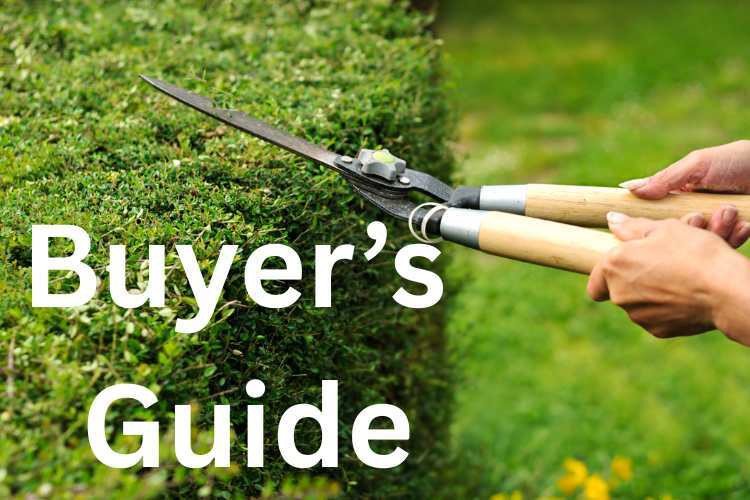
We all love a hedge. Or at least most of us will have a hedge or two in our garden. After all, they not lonely look good they mark boundaries, add security, and attract wildlife. So, at some point we’ll all be pondering whether or when to buy new hedging plants.
Whether you're new to gardening or have seasoned green fingers, you’ll know that choosing and planting the right hedge will dramatically change the appearance of your garden. For the better of course.
If you’re considering a new hedge or looking for hedging plants to plug a gap in the garden this guide is for you. We'll cover everything from understanding the unique characteristics of evergreen and deciduous hedges to the practicalities of planting and maintenance. We’ll also find some time to troubleshoot some common issues you may come across.
Whether your aim is to create a privacy screen, attract more wildlife, reduce noise and wind, or simply add structure and colour, we’ve got you covered.
Why Plant a Hedge?
Looks Great
Granted an old, unkempt hedge looks horrible. But with a minimum of care your hedge will look fabulous. You don’t have to aspire to the formal country house style hedge but your hedging plants will definitely add to the appearance of any garden by providing structure and definition. Don’t forget a hedge can frame garden features such as paths, flowerbeds, and lawns. And while many popular hedging plants are evergreen, others offer seasonal interest, with some varieties displaying colours, blossoms, or berries.
Here is your text with the appropriate HTML tags added while keeping the text exactly as you provided it:
They’re Practical Things
Looks aren’t everything. And hedges really are practical things. The most obvious and popular reason for anyone planting a hedge is for privacy. A dense, well-grown hedge provides a natural barrier from neighbours, passersby, and busy roads. And, unlike traditional fencing, hedges offer a softer, more natural appearance.
But keeping nosy neighbours out isn’t the only reason to plant a hedge. They also make excellent windbreaks, protecting your garden and home from winds. A strategically placed hedge can help shelter delicate plants, reduce soil erosion, and even extend how long you can spend in your outdoor spaces by shielding patios and seating areas.
Perhaps surprisingly they also reduce noise because they will absorb the sounds from passing traffic and properties. This makes them ideal for urban gardens or those near busy roads.
Of course, hedges also serve as property boundaries, which is why ‘instant hedges’ are so popular with developers. They also help prevent unwanted access, adding an extra layer of security to your property. For households with children or pets, hedges provide safe and enclosed outdoor spaces.
Lastly, hedges provide shade, helping to cool your garden during hot summer months.
Environmental Benefits
Your hedging plants will be attractive to birds and insects. They can provide shelter, nesting sites, and food sources. They’ll also help pollinators like bees and butterflies. But wait, there’s more. Hedges improve air quality by trapping pollutants and dust particles and can even reduce soil erosion by stabilising the ground with their root systems.
Types of Hedging Plants
Evergreen Hedging
Evergreen hedges provide year-round foliage and are ideal for privacy and structure. Some to look at include:
- Box (Buxus sempervirens): Dense foliage, easily shaped, ideal for formal gardens.
- Yew (Taxus baccata): Hardy, excellent for formal hedging, tolerates shade.
- Privet (Ligustrum ovalifolium): Fast-growing, versatile, easy to maintain.
- Laurel (Prunus laurocerasus): Large glossy leaves, rapid growth, excellent privacy hedge.
Deciduous Hedging
These hedges lose leaves in autumn, often showcasing beautiful seasonal changes. Consider:
- Beech (Fagus sylvatica): Retains leaves through winter for added privacy, beautiful coppery foliage.
- Hornbeam (Carpinus betulus): Hardy, similar appearance to beech but better suited for damp or clay soils.
Flowering Hedging
Adds colour and fragrance to your garden. Popular types of flowering hedging include:
- Forsythia: Bright yellow early spring blooms.
- Viburnum tinus: Evergreen foliage with fragrant white blossoms through winter and spring.
- Escallonia: Vibrant, attractive flowers, ideal for coastal gardens.
Native and Wildlife-Friendly Hedging
Perfect for enhancing and attracting wildlife. This type of hedging plant includes:
- Hawthorn (Crataegus monogyna): Dense, thorny hedge with spring blossoms and autumn berries.
- Blackthorn (Prunus spinosa): White flowers in spring, produces sloes, great for wildlife.
- Holly (Ilex aquifolium): Evergreen, Ilex holly provides winter berries, great for birds.
Edible Hedging
Combine aesthetics with edible fruits because, why wouldn’t you?
- Blackthorn (Sloe): Produces sloes, excellent for sloe gin.
- Hazel: Nuts in autumn, attractive foliage.
- Elder (Sambucus nigra): Attractive flowers and berries, great for wildlife and home produce.
Choosing the Right Hedge for Your Garden
What’s Your Garden Like?
Most hedging plants are hardy and adaptable but some will thrive in different soil types. Is your soil sandy, clay-based, or loamy? Some hedging plants prefer acidic soils, while others flourish in alkaline or neutral conditions.
Growth Rate and Maintenance
Some of us want to plant a hedge and see it reach maximum height as swiftly as possible (leylandii anyone?). Others may be happy to wait. But hedging plants vary considerably in growth rates. Fast-growing hedges like Privet or Cherry Laurel quickly establish boundaries and screens, but require regular pruning to maintain shape. In contrast, slow-growing hedges such as Yew or Box need less frequent trimming but take longer to reach their desired height.
Height and Size
The best height and size for your hedge depends on its purpose. If privacy or screening from neighbours is a priority, taller varieties like Leylandii or Laurel might be ideal. For boundary marking, lower-growing hedges like Box could be suitable.
Budget
As a general rule, hedging plants are the best value plants you can buy. But costs will vary based on the hedge type, size, and maturity. For example, a five-foot mature conifer will of course be more expensive than a 12-inch young plant. Additionally, bare-root plants can be cheaper but are only available seasonally and may require more initial care.
Planting Your Hedge – Step by Step
When to Plant Your Hedge
Bare-root hedging plants are generally best planted during their dormant season, typically from late autumn through winter to early spring. Container-grown hedges offer greater flexibility and can be planted at any time of the year, provided that the ground is not frozen or waterlogged.
Soil Preparation
You don’t need much prep before planting your hedge but start by clearing weeds, grass, and debris from the planting area. Then improve the soil structure with well-rotted manure or compost to help with drainage, nutrition, and moisture retention.
Spacing and Planting
Pay attention to spacing. Generally, smaller hedging plants should be planted 30-50cm apart, while larger or faster-growing species may need spacing of 60-100cm or more. When planting, dig holes deep enough to comfortably accommodate roots and plant at the same depth as grown in the nursery. Backfill the hole carefully, and water thoroughly to help get your hedging plants established.
Establishment and Aftercare
After planting, regular watering, especially during dry periods, will help your plants establish themselves. Mulching around the base of the plants will retain moisture, suppress weeds, and regulate the soil temperature.
Maintaining and Caring for Your Hedge
Pruning and Trimming
Regular pruning and trimming will keep your hedge healthy, and will also let you control its shape and density. Formal hedges typically require trimming twice a year, usually in late spring and early autumn. Informal hedges can be pruned less frequently—once a year is generally sufficient—allowing them to develop a natural, relaxed form. Probably goes without saying but when pruning your hedge always use sharp tools. You need clean cuts to avoid damaging your hedging plants.
Feeding and Fertilising
Applying an annual feed of a balanced, slow-release fertiliser in early spring will give your hedge all the nutrients it needs for the growing season. Organic material like compost or well-rotted manure will improve soil structure and support long-term soil health. If you do use a fertiliser, make sure it's distributed evenly around the base of the plants and water thoroughly after using.
Watering
Proper watering is important during the first few years after planting, when hedging plants are establishing their root systems. New hedges need consistent moisture, so regular watering during dry spells is critical. Established hedges are generally more drought-tolerant but may still benefit from occasional deep watering during prolonged dry periods.
Pest and Disease Management
Regular inspection and timely intervention are key to managing pests and diseases effectively. Common pests include aphids, scale insects, caterpillars, and vine weevil larvae, which can damage leaves and roots. Diseases such as box blight, powdery mildew, and honey fungus can also affect hedges. Preventive measures include ensuring proper spacing, improving air circulation through pruning, and removing infected plants.
Winter Care
Winter protection helps hedges withstand harsh weather conditions. Ensure your hedges are adequately mulched to insulate their roots against severe frost. For young plants, temporary windbreaks or fleece coverings can offer protection against damaging cold winds. After heavy snowfall, gently remove accumulated snow to prevent branches from breaking under its weight.
Don’t forget to check out our huge range of hedging plants. They’re all ready to be picked, packed, and dispatched direct to your door.
Frequently Asked Questions
Can hedging plants grow in shade?
Yes, many hedging plants thrive in the shade. Yew, Holly, and Privet are excellent examples of this. But before buying any hedging plants always check their characteristics to ensure optimal growth and health.
How quickly will my hedge grow?
Growth rates vary significantly between species. Fast-growing hedges like Leylandii and Laurel can grow up to 60cm a year under ideal conditions, while slow-growing types such as Yew and Box grow more gradually, typically 10-20cm per year.
Can I move established hedges?
While it’s possible to relocate an established hedge, it can be challenging and risks plant health, especially with mature hedges. Transplanting is best done during the plant’s dormant season. But, on the whole, it’s a bad idea.
Are hedges difficult to maintain?
No, of all the different garden plants hedges are pretty easy to look after. Of course, formal hedges will need regular trimming and care, but for most of us our hedges will just need a once-a-year trim and a bit of feeding.
What can I do about gaps in an existing hedge?
Gaps in hedges can happen because of disease, pests, or something as daft as the dog bursting through. To fill gaps, prune surrounding branches to encourage new growth or even consider integrating climbing plants for immediate coverage. Regular feeding and watering will help newly planted sections establish more quickly.
The Last Word
Whether you're an experienced gardener or a complete novice, planting and caring for a hedge is enjoyable and will (literally) add a new dimension to your garden. Shop with Direct Hedging Plants and you’ll soon make your garden a more attractive, tranquil, and wildlife-friendly space.

